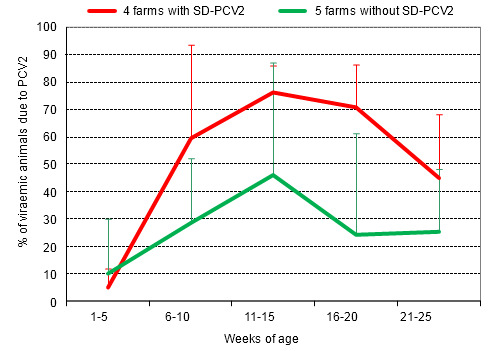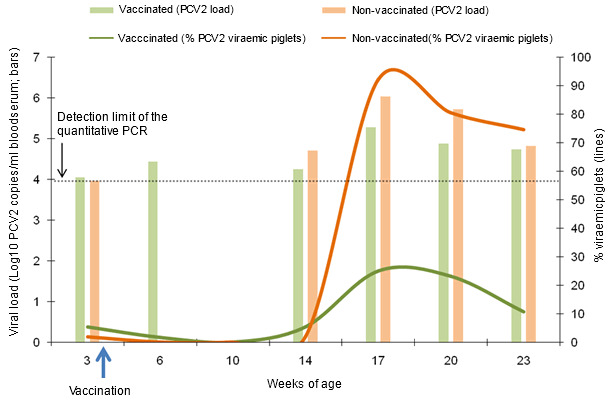The pathology associated to the porcine circovirus type 2 (PCV2) and its resulting production losses in the swine livestock has been the object of study since it was associated, in 1998, with the porcine circovirosis, also called, currently, systemic disease due to PCV2 (PCV2-SD). Since then, it has been related to different pathologies that need a systemic infection as, for instance, the PCV2-SD and the subclinical infection (PCV2-SI) in animals in the weaners and the fattening stages, as well as a reproductive disease (PCV2-RD) in pregnant sows. The PCV2 has also been associated to diseases that affect, apparently, specific organs, as in the case of the lung or the enteric disease. Also, even today, the PCV2 is associated to the porcine dermatitis and nephropaty syndrome, although being considered as a disease mediated by immunocomplexes without a definitely demonstrated etiology.
The systemic infection of an individual appears when the PCV2 spreads through the body, being the blood circulation the vehicle for its dissemination. This phenomenon in which the virus is found in the blood is called viraemia. In conventional farms, it is frequent to find viraemic animals during the end of the weaners stage and the fattening stage. It has been seen that the presence of viraemic animals due to the PCV2 occurs with a higher frequency and earlier in farms with PCV2-SD (Figure 1). The establishment (or not) of a viraemia is associated to the presence of immunity against the virus at the moment of the infection. So, the maternal immunity can protect the piglet during its first 4-12 weeks of age, although subsequently a viraemia normally appears until the piglet develops an active response. Nevertheless, the establishment of this response not always implies the elimination of the viraemia, but it does reduce the viral load. In fact, unlike other porcine viruses, the viraemias due to PCV2 have a variable way of working (regardless of the presence or not of PCV2-SD in the farm), in which it is frequent to find an important proportion of the animals with intermittent and/or long lasting viraemias that can go on until the 28th week of age. So, it is not strange to find the coexistence of viremia and antibodies against the PCV2 during all the fattening stage. Recently, the implementation of the monitoring of the infection in the farms through the analysis of oral fluids due to its lower financial cost has started, and we have been able to verify efficiently, also with this method, the long-lasting persistence of the virus in the animals that are growing, even in farms that vaccinate against the PCV2.


Fig. 1. Percentage of viraemic piglets with respect to the PCV2 in farms with and without PCV2-SD (adapted from Sibila et al., 2004 Am J Vet Res).
The PCV2-SD is, probably, the disease caused by the PCV2 with a higher financial impact because it causes losses in the average weight gain and the feed conversion ratio, and because it increases the mortality remarkably. The different experiences in farms with and without the disease (although infected by the PCV2 in both cases) have shown that the infection pressure has a direct impact on the production losses of the animals that are growing. We have been able to check this fact after applying different management measures focused on limiting the spreading of the disease, as can be the case with the 20 Madec items suggested in year 2000. In the same way, we have seen, in many studies, that the animals with clinical signs of PCV2-SD have a viral load in the blood significantly higher in comparison with healthy piglets. In fact, viremia levels were suggested, and when the levels found where higher than the suggested ones, it could be considered that an animal suffered PCV2-SD (varying from > 104.7 to 107.4 copies of PCV2 genome/ml of blood serum, depending on the laboratory that performed the analysis). These results tell that high PCV2 levels in the blood are critical for the expression of the disease. So, the losses associated with the PCV2 are not only related to the presence (or not) of viremia, but also to the amount of viruses. In this sense, nowadays we know that in order for the PCV2 to cause losses due to the reduction of the average weight gain, it is not necessary for the viral load to be so high as the one found in the animals affected by the PCV2-SD. Low to moderate viral loads already cause significant growth losses, as it happens in the case of the PCV2-SI, and this has been clearly seen by means of vaccines in farms without PCV2-SD in which the vaccinated piglets or those born to vaccinated sows had a daily weight gain of + 20-51 g. This fact has been, without a doubt, a step forward into the knowledge of the pathology associated to the PCV2, and it is the one that explains that farms that considered that the PCV2 was not a problem have decided to vaccinate and have had profitable results.
In adult animals the viremia is less frequent than in animals that are growing, because the previous contact with the virus during the weaners and/or the fattening stages grants them immunity. So, the viremia during the pregnancy stage can give a result PCV2-RD, because the virus can go through the placenta and cause different clinical manifestations according to the moment of the infection during the pregnancy, as it is explained in Table 1. There is also the possibility that viremic piglets are born to viremic sows beceuse they have been infected through the placenta during the gestation, being then a source if infection of the animals that are in their surroundings. Nevertheless, these situations have been mainly described in seronegative sows, being this a rare fact given the high seroprevalence against PCV2 in this group of animals due to the previous contact with the virus during the weaner and/or the fattening stages, and due to the recirculation of the virus in the sows. Even so, we must comment that the fact of having immunity, whereas vaccinal or derived from a previous infection, does not exclude the viremia, so the infection through the placenta is also possible in seropositive sows.
| Moment of the infection of the foetus during the gestation | Consequence on the reproductive parameters |
| 1st-35th day |
Embryo death |
| 35th-70th day | Mummified foetuses Abortions |
| 70th-115th day | Mummified foetuses Piglets born dead (stillbirths) Piglets born being weak Late births Abortions |
Table 1. Reproductive problems associated with the PCV2 according to the moment of the infection of the foetus during the gestation (adapted from Opriessnig and Langohr, 2012 Vet Pathol).
So, the viraemia due to the PCV2 is the indicator of a systemic infection due to the virus that is able to cause production losses in growing piglets and in pregnant sows. The most effective way to avoid the production losses related to the PCV2 is to avoid the viremia, inducing a passive or an active immunity that minimizes the circulation of the virus in the farm. In this sense, the vaccines have proven that they reduce significantly the percentage of viraemic piglets, as well as the viral load in the blood (Figure 2) and the virus excretion, and it is here where the key of their success seems to be: in the remarkable improvement of the production parameters. Even so, we must say that the vaccines against the PCV2 in sows, as well as in piglets do not cause a sterilizing immunity, so the infection go on in the farm.

Figure 2. Comparative figure of the dynamics of the percentage of viraemic piglets (lines) and the average viral load in the viraemic piglets (bars), both of them measured with quantitative PCR, in animals vaccinated at 3 weeks of age and not vaccinated against the PCV2.




